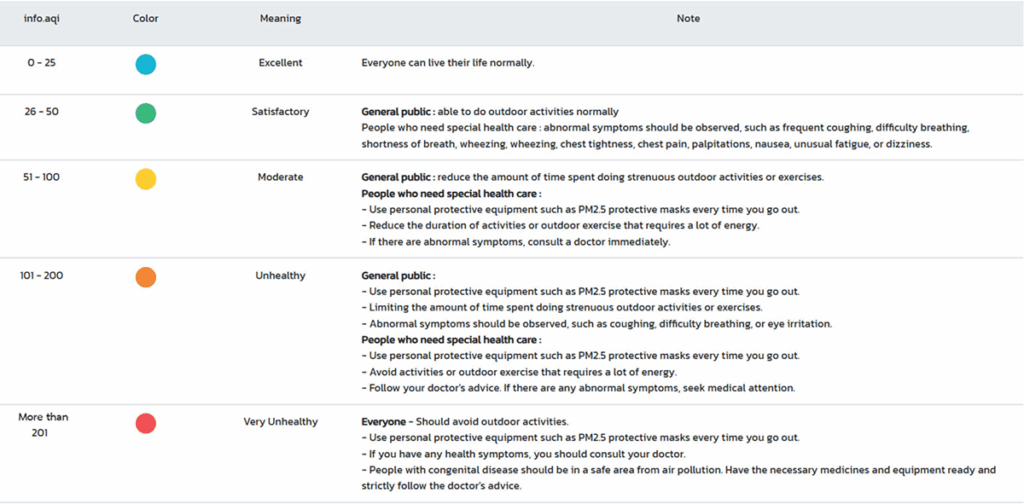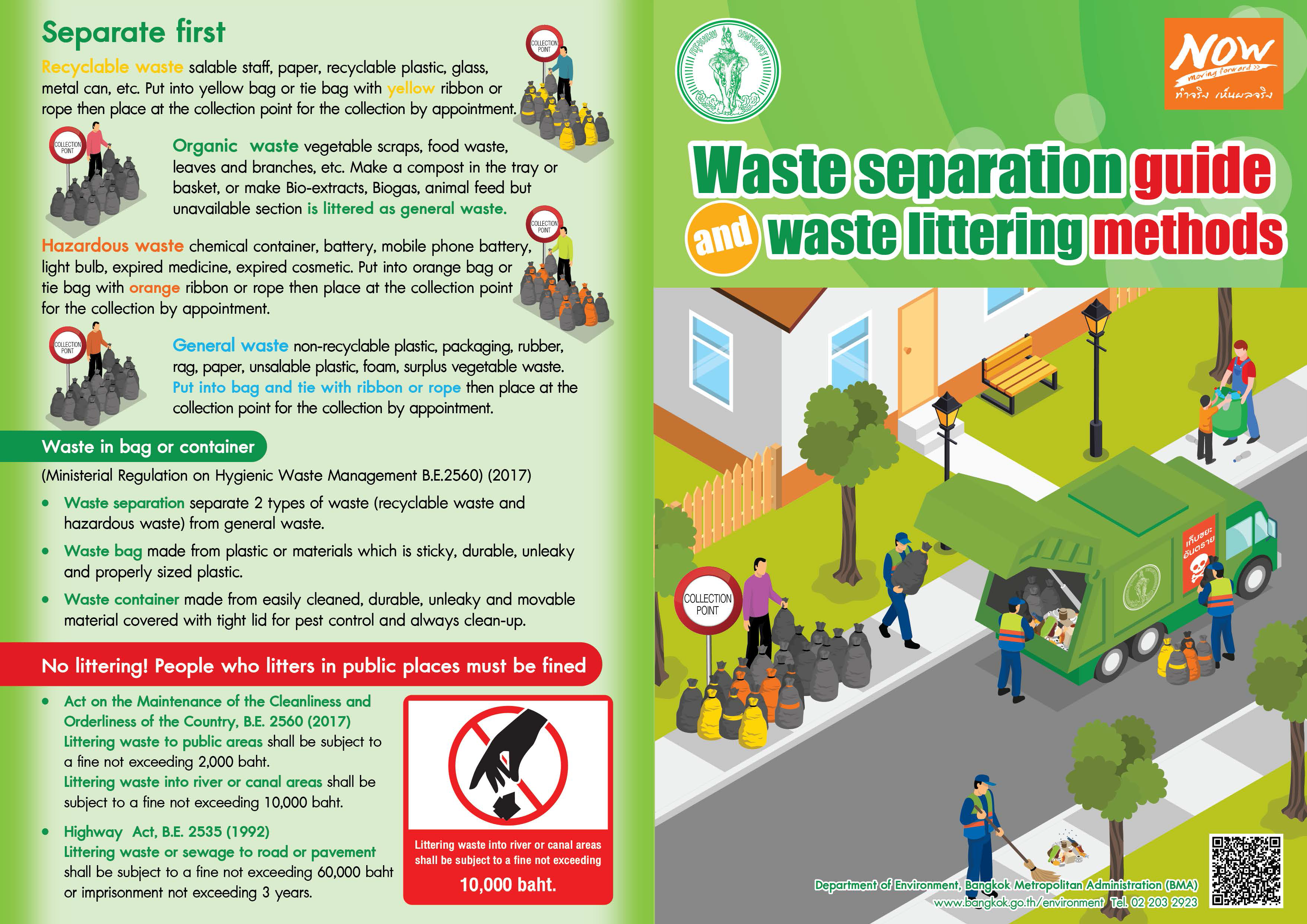Environment in Bangkok: What to know.
Explore how Bangkok is tackling pollution, green space, and
sustainability.
PM2.5 Monitoring
Air Quality Index : AQI
It is a report on air quality information in a format that is easy for the general public to understand. To disseminate information to the public about the level of air pollution in each area Does it affect health? One air quality index is used to represent the concentration of 6 air pollutants as follows
Dust with a diameter of not more than 2.5 microns (PM2.5) is a dust with a diameter of not more than 2.5 microns caused by combustion from vehicles. Burning agricultural materials, forest fires, and industrial processes can reach the air sacs in the lungs As a result, it can cause diseases in the respiratory system. and various lung diseases If given in large quantities or for a long time, it will accumulate in the lung tissue. causing the lung function to deteriorate due to bronchitis asthma
Particulate matter less than 10 microns (PM10) is dust with a diameter of not more than 10 microns caused by fuel combustion. Open fire Industrial processes, grinding, milling or powdering of construction affect health because inhaling it can accumulate in the respiratory tract.
Ozone gas (O3) is a colorless or light blue gas with a pungent odor. Slightly soluble in water. Occur both at high levels of the atmosphere from the earth’s surface and the level of the Earth’s atmosphere near the ground. Ozone gas is an air pollutant is ozone gas in the Earth’s atmosphere caused by the reaction between nitrogen oxides and volatile organic compounds with sunlight as a catalyst. If affects health by causing the irritation to eyes, the respiratory system, and mucous membranes. It decreased lung capacity whiel tired quickly, especially in children, the elderly, and people with chronic lung disease.
Carbon monoxide (CO) is a colorless, odorless and tasteless gas produced by the incomplete combustion of carbon-containing fuels. This gas can accumulate in the body where it combines with hemoglobin in red blood cells about 200-250 times better than oxygen. When inhaled, this gas will compete for hemoglobin in the blood. This results in carboxyhemoglobin (CoHb) which facilitates the reduced transport of oxygen to cells of the body. As a result, the body becomes weak, and the heart works harder.
Nitrogen dioxide (NO2) is a colorless and odorless gas which slightly soluble common in nature , or caused by human actions such as burning various fuels, some industries, and etc. This gas affects the visual system and people with asthma or respiratory diseases.
Sulfur dioxide (SO2) is a colorless gas, or may have a light yellow color. It has a high concentration of flavor and smell caused by nature and burning fuels with sulfur as a component. It is good at water solubility and combine with other pollutants to form fine dust particles. This gas has a direct impact on health. It causes irritation to conjunctiva, skin and the respiratory system. If taken for a long time, it can cause chronic bronchitis.
Thailand’s air quality index is divided into 5 levels, ranging from 0 to 201 and above, with each level using colors to symbolize the level of health impacts (Table 1) The air quality index of 100 is equivalent to the general atmospheric air quality standard. If the air quality index is higher than 100, the air pollution concentration value is above the standard and the air quality on that day will begin to affect public health.
Table 1 Criteria of Thailand Air Quality Index

Calculation of the daily air quality index of each air pollutant Calculated from the concentration of air pollutants from air quality measurement results. The levels of air pollutant concentration values are equivalent to the air quality index values at various levels as shown (Table 2) is a straight line equation as follows set to I = Air quality sub-index X = Concentration of air pollutants from the measurement Xi , Xj = The minimum, maximum value of the pollutant concentration range with the value X. Ii , Ij = The minimum, maximum value of the air quality index range corresponding to the concentration range X from the calculated subindex. Which air pollutant has the highest index? It will be used as the Air Quality Index (AQI) at that time.
Table 2 Air Pollution Concentration Equivalent to Air Quality Index

Average interval and the air pollutant unit used in the calculation
- PM2.5 24 hours continuous average: micrograms per cubic meter or µg/m³
- PM10 24 hours continuous average: micrograms per cubic meter or µg/m³
- O3 8 hours continuous average: parts per billion or ppb or 1/1,000,000,000
- CO 8 hour continuous average: parts per million or ppm or 1/1,000,000
- NO2 1 hour average: parts per billion or ppb or 1/1,000,000,000
- SO2 1 hour average: parts per billion or ppb or 1/1,000,000,000
Frequently asked questions
What is the standard value of PM2.5 ?
The standard value of the 24 hour average should not exceed 37.5 micrograms per cubic meter. The standard value of the annual average should not exceed 15 micrograms per cubic meter.
What is the air quality index?
Jodd Fairs refers to two-night markets in Bangkok: the original location at Rama 9 and the newer one at Dan Neramit.
Interpretation of color scale
Indy Market is a relatively new night market on the Thonburi side of Bangkok. It caters more towards locals but is becoming increasingly popular with tourists as well.
Why is Thailand's AQI not the same as that of the United States?
When converted to AQI color scale at the same amount of pollution it is found that Thai and foreign colors are used differenly. However, the difference lies only in the representation of the colors. Asking the public to understand the level of health warnings you Will find that the health warnings in Thailand and abroad are the same.
The area near my home does not have measurement data.
Pak Khlong Talat, also known as the Bangkok Flower Market, is Thailand’s largest wholesale flower market. It is considered one of the top ten flower markets in the world. It is a must-visit for anyone interested in flowers or looking to experience a vibrant aspect of Bangkok’s local life.
What are 'People who need special health care' and 'General public' meaning ?
“Khlong Thom Market, also known as the Khlong Thom Night Market or Thieves Market, is one of the oldest and most interesting street markets in Bangkok. It’s a great place to find unexpected treasures and experience a more local side of Bangkok.”
Ensuring the safety of
expatriates residing in
Bangkok.
Bangkok offers a great expat life, but like any city, there are areas to be aware of for safety. Here’s a breakdown of safety concerns and precautions for expats in Bangkok.
Petty Theft
Bag snatching and pickpocketing can happen, particularly in crowded areas or at night. Keep valuables secure, avoid displaying them in public, and be mindful of your surroundings.
Scams
Expats might be targeted for scams involving overpriced rentals, fake language schools, or gem scams. Research thoroughly before signing any contracts or making purchases.
Traffic
Bangkok's traffic is notorious. Learn local traffic rules, be cautious when crossing streets, and consider ride-sharing apps (Grab, Uber) instead of taxis at night, especially for solo travelers.
Air Quality
Air pollution can be a concern, especially during dry seasons. Invest in a good quality mask, particularly if you have respiratory issues.
Accommodation
Choose a safe neighborhood with good security features in your building. Many expat-friendly areas exist, like Sukhumvit.
Transportation
Use ride-sharing apps or metered taxis. Avoid unbooked motorcycle taxis, especially at night.
Nightlife
Be cautious in areas known for nightlife, especially if alone.
Culture
Respect Thai customs and dress modestly, particularly in religious areas.
Role of a Security Guard

Crowd Control

Powers of Arrest

Patrol Techniques

Use of Force

First Aid


Additional Information
Expat Forums
Connect with other expats online for first-hand experiences and safety advice. Several online communities cater to expats living in Bangkok and Thailand. Here are a few popular options.
Thailand Expat Forums: This forum is dedicated to expats living in Thailand and covers a wide range of topics, including safety, visas, healthcare, accommodation, and social events
Thaiger Talk Thailand Forums: This forum features discussions on various aspects of life in Thailand, including news, current affairs, travel, and expat experiences.
Expat Exchange Bangkok Forum: This forum focuses specifically on living in Bangkok and offers information on navigating daily life, finding housing, healthcare, and connecting with other expats.
InterNations Bangkok Expats: InterNations is a network for expats worldwide, and their Bangkok group allows you to connect with other expats living in the city. This can be a great option for finding social events and getting firsthand advice.
Choosing the Right Forum
The best forum for you will depend on your specific needs and interests. Here are some factors to consider.
Focus: Some forums are general and cover a wide range of topics, while others may focus on specific areas like business, families, or retirees.
Activity Level: Look for a forum with active discussions and helpful members.
Search Functionality: A good forum should have a search function that allows you to find information on specific topics. Registration: Some forums require registration to participate in discussions, while others allow you to browse anonymously.
Additional
There are numerous Facebook groups dedicated to expats in Bangkok. Search for groups based on your interests or nationality.
Embassy Websites
Your embassy website will offer safety information specific to your nationality. Many embassies have resources and information for their citizens living abroad, including expat forums or online communities.



Local News
Stay informed about current events and any potential safety concerns.





